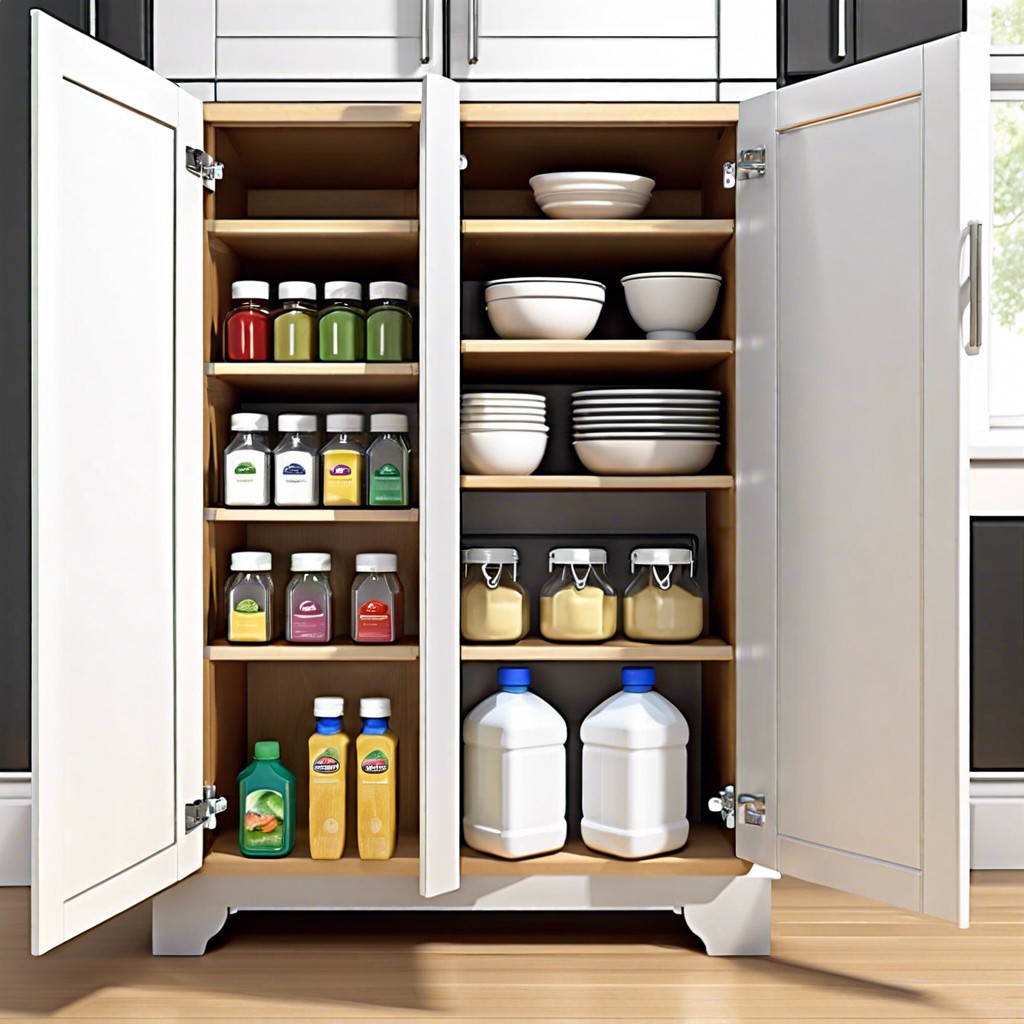Last updated on
Store chemicals in a clearly labeled, secure cabinet away from food and heat sources in a kitchen.
Key takeaways:
- Dedicate a Specific Cabinet for Chemicals Away From Food Areas
- Lock Cabinets Containing Hazardous Substances
- Clearly Label Storage Areas for Chemicals
- Use Child-proof Locks If Necessary
- Keep Safety Data Sheets (SDS) Accessible
What's Inside
Dedicate a Specific Cabinet for Chemicals Away From Food Areas

Segregating substances like cleaners and sanitizers is essential in preventing accidental food contamination. Opt for the highest shelf to thwart any adventurous little hands or paws from making a hazardous discovery. Picture a chef carefully selecting a spot that’s a stone’s throw away from edibles, almost like setting up a quarantine zone in the pantry.
It’s crucial too that this reserved space isn’t directly above any food prep areas. A spill could turn disastrous. Think of this storage area as an exclusive lounge for chemicals, where the dress code strictly bans anything edible. This separation is not just good practice; it’s a culinary commandment—thou shalt not mix bleach with the béchamel.
Remember, putting a firm boundary between sustenance and substances drastically reduces the risk—and no one’s ever regretted playing it safe in this game of kitchen Tetris.
Lock Cabinets Containing Hazardous Substances
Securing dangerous substances behind lock and key is a smart play. Think of it as a goalie in soccer—there to block unwelcome accidents from getting through. Imagine mixing bleach with your pasta because they were snuggled together—yikes, not a tasty combination!
Here are a few whys and hows of locking up:
– Safety first: Prevent mishaps by making sure those powerful cleaning potions are out of reach from curious hands—kids can be little Houdinis!
– Picky with location: Choose a cabinet high up or in a low traffic zone. You don’t want a bottle of floor cleaner tumbling out while reaching for a frying pan.
– Double-duty locks: They’re not just for kids. In a busy kitchen, it’s easy for anyone to grab the wrong bottle in the heat of the moment.
Key takeaway: Treat those chemicals like VIPs in a secure club—they need special access. A little foresight goes a long way in keeping your kitchen squad safe and your meals chemical-free!
Clearly Label Storage Areas for Chemicals
Legibility is your friend. Slap big, bold labels on those chemical containers so there’s no mistaking the bathroom cleaner for the olive oil. Let’s face it; in the heat of the kitchen hustle, even Chef Extraordinaire could make a blunder.
Safety first, second, and third. Visual cues are the secret sauce to avoiding mishaps. Imagine your labels as little superheroes that stand guard against mix-ups. Employ symbols and color codes—the fewer words, the better. Quick glances should suffice to keep things crystal clear.
Now, let’s talk organization. Group similar products together like a culinary mise en place, but for your cleaners. This strategy simplifies finding the right substance and returning it to its rightful spot without a game of Tetris.
Remember, in a busy kitchen, clarity saves the day—and quite possibly, the soup of the day as well.
Use Child-proof Locks If Necessary
Let’s face it, kids are like mini Houdinis; they can find their way into almost anything. That’s why, if you have little ones running around, incorporating child-proof locks can be a game changer. Think about it – those curious hands won’t stand a chance against a securely locked cabinet. And it’s not just for kids. Pets with nimble paws or seniors with shaky hands might mistakenly grab a chemical instead of their snack. So, a simple lock does more than just protect the tots; it’s a buffer against accidents for all family members.
Selecting the right lock might seem like a small detail, but it holds significant weight. There are a variety of locks, from magnetic styles that intrigue with their invisible security to traditional latch upgrades that could even stump some adults. Whichever route you take, make sure it’s something you can operate easily in the hurry of daily life. After all, convenience should hold hands with safety.
Installing these locks is typically a breeze. Many don’t even require you to be handy with tools. With stick-on options, you can have them in place faster than you can say “no touchy!” Sure, it may take an extra second to open a cabinet, but that’s a blink in time compared to the peace of mind you gain.
Keep Safety Data Sheets (SDS) Accessible
Having quick access to Safety Data Sheets can be a game-changer in emergency situations. These documents provide vital information on the chemicals, including their hazards and instructions for safe handling.
First off, store them in a clearly marked binder or folder near the chemicals for efficiency. This makes it a cinch for anyone to grab them in a pinch. It’s equally smart to familiarize yourself and staff with their location and content. Regular briefings ensure that everyone is up to speed. Moreover, consider having a digital backup. In this way, if the physical copies are unavailable, the information is just a few clicks away on a computer or smartphone.
Remember, knowledge is power, especially when chemicals are in play. Accessible SDSs arm you with the right information to handle substances safely and react swiftly if things go south.




